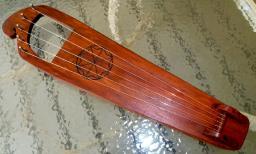There is going to be some manner of brass used in this project. That black piece where the stings run over the courses is plastic. Sure, a hard plastic, but I think brass would be a better option. This was not a high digit instrument. But with some careful consideration, it can become mighty fine. Just need to exercise the necessary care to make sure the brass is good and straight, no kinks allowed. A soft 'bow' maybe, but that is it.
Brass would be good at the tail, but wood would look better...decisions, decisions... Either way, there should be some "shaping" to get the piece to look right.
Ah, the strings. I have done a LOT of rooting about the net on that. I do believe I have the gauges now. It is also fairly apparent that the strings are indeed ball end guitar strings. There is a place I go for my dulcimer strings that can set me up with what I need. ~L~ At that point it is choosing the correct TYPE of string. One site I looked at likened the strings to gauges of piano wire.
As a retired machinist and tool maker, I know WD-40 quite well. But using it on a tuning peg in wood? Maybe a q-tip and daubing? But a goof tip. Not one I would have considered, but it sounds like a plan.
"Make a note about the note they are tuned..." Hoboy, done. After that, there is the world of confusion that goes into all of the alternate tunings. Is Draconian an type of tuning?
Then, after all that, clean the poor baby and have a look, eh?
There WILL be sanding and refinishing. This is something I enjoy quite a lot. There are some nasty looking marks on the edge of the face that need to be addressed. Short of the playing once the work is done, the wood working part of this is going to be one of if not THE best part of the project.
The more I look at this thing the more I am convinced that the "finish" is about as minimal as it gets. "Student" instrument was mentioned. Sounds about right to me. I am leaning toward a lacquer or shellac for the finish. Needs to be water based though as I do not have good ventilation and cannot access a spray booth. Yup, spray. ~L~ I do NOT have the arms to do a French rub.
To stain or not to stain...
I want to thank you all for the ideas and suggestions. I have never worked with an instrument before. Not a decent one. I can use ALL the help I can get.


